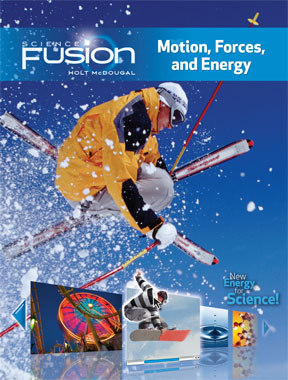ScienceFusion is a comprehensive science curriculum for grades K through 8 that is significantly different from everything else on the market because of its unique integration of print and e-learning resources. While it was created for traditional school settings, Homeschool Kits make it relatively affordable for homeschoolers.
Homeschool Pacing Guides chart out the use of each lesson component, indicating approximately how much time will be required. Time required is flexible because of the program’s design.
A complete teacher’s edition is available through the online teacher resources. You need to use this for an explanation of lesson presentations and for your answer key. Teacher support materials provide all the help you might need online.
Experiments and activities are presented through online Inquiry Flipcharts. Levels K through 5 student books have pages for recording and evaluating lab work. Lab activities, lab manuals, and data sheets for grades 6 through 8 are online rather than within student worktexts.
Quizzes and tests are also online. Students can take the tests online and they are automatically scored.
An optional class management system allows you to schedule assignments and tests. It also allows you to view logs of student online work. Students can access their own account to get their lesson assignments each day. This might be especially valuable for older students working independently at least part of the time. However, lessons are really designed for discussion and collaboration. While it is possible for a student to work through lessons on his or her own to some extent, this is not the best way to use the program. Some lab activities are designed for collaborative work. When this isn’t possible you might choose to have your child view a virtual lab instead.
Houghton Mifflin Harcourt describes this program as being multi-modal. This means that lesson concepts are presented through a variety of learning modalities. Core concepts are taught in the print book as well as through an online lesson. While lessons deal with the same concept, they each present the material in a different context. You can use both modes of lesson presentation or select one or the other. Students can read, write, view pictures, listen to audio presentations, watch videos, engage in activities, work independently, or work collaboratively.
You will likely use a mixture of book-based and e-learning as well as hands-on activity so you will not use one method exclusively. The format for both book and online lessons looks like a magazine with lots of visuals that help illustrate and explain the lesson concept. The amount of text to read per lesson is less than you find in most other textbooks. Students write directly in their texts so they are not reusable.
ScienceFusion is an inquiry program which means that it doesn’t just present information. It begins lessons with questions to engage student interest. Students read some information (or listen to an audio-visual presentation). But students are continually challenged to think about real-life applications, to restate concepts in their own words, to research, and to think beyond the information that is presented. STEM skills in science, technology, engineering, and math are emphasized throughout the series so that students acquire an understanding of how science knowledge is used in real life.
The viewpoint is secular, so Christians can expect some of the typical problems with evolution and the age of the earth. Physical science topics are generally not problematic. Throughout the curriculum, you will encounter passing mentions of evolution and millions of years. Most problematic should be The Diversity of Living Things and The Dynamic Earth. Some home educators will also take issue with some content in Ecology and the Environment when it deals with humans’ impact on the environment.
Houghton Mifflin Harcourt has chosen an interesting way to present the program for grades 6-8. While younger grades are each contained in a single course (each including topics from life science, physical science, and earth and space science), for the middle grades, courses are taught in 11 topical modules. Parents and teachers are welcome to select which modules to use and in which order to use them. Each module is complete in itself with all of the above-described components. Modules are Cells and Heredity; The Diversity of Living Things; The Human Body; Ecology and Environment; The Dynamic Earth; Earth’s Water and Atmosphere; Space Science; Matter and Energy; Motion, Forces, and Energy; Sound and Light; and Introduction to Science and Technology. Modules vary in length, but it appears that you would need to complete about three per year.
ScienceFusion Homeschool Kits for each course or module include a student worktext plus the Online Student Interactive Digital Curriculum and the Online Teacher Digital Management Center. You have access to online content for 12 months.
ScienceFusion is a beautifully presented and technologically rich program that is engineered to help students with different learning styles be successful. It also engages students in the world of science in a manner likely to create enthusiasm and interest. Aside from potential philosophical problems, the only downside to this program is that it has so many components and unusual methods of presentation that it is difficult to figure out how to locate and use them. You need not use everything, but do allow time to explore the program, find the essential components, and get a handle on how to use it before it’s time to begin teaching.
Note (2/6/13): Since I posted my original review, I've gotten feedback that the location and use of components really has proven cumbersome to at least a few homeschoolers. One parent commented that quizzes and tests for the fifth-grade program had some questions on content that was not covered in either print or digital lesson material. While this program has many merits, I think it is important to pass on these cautions that users have raised.

















